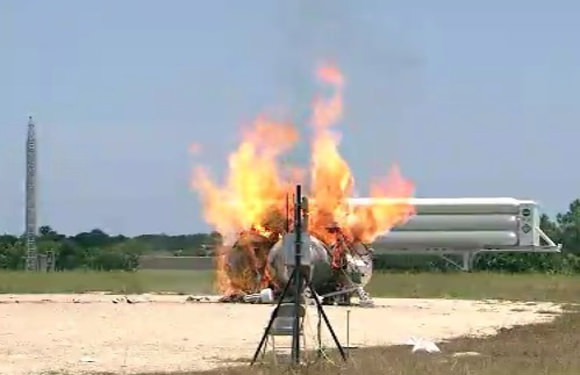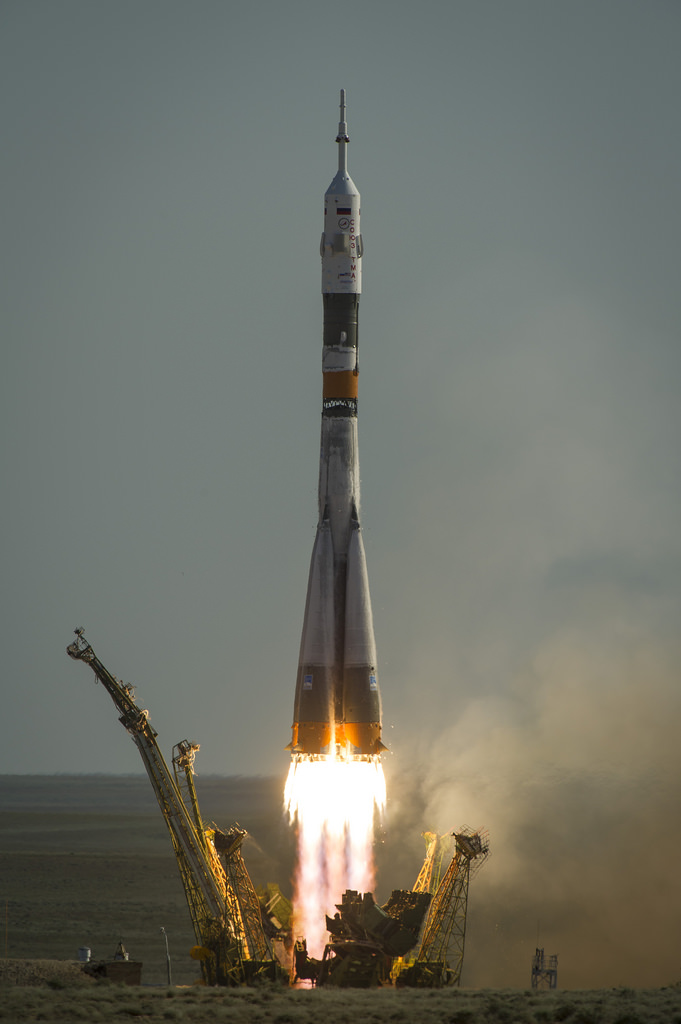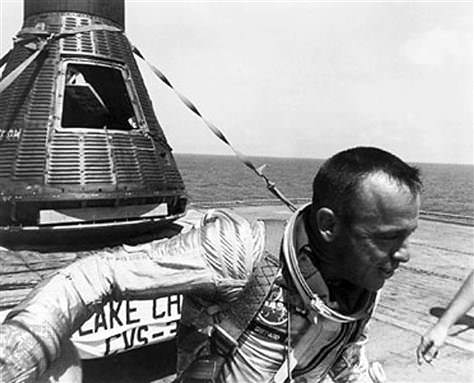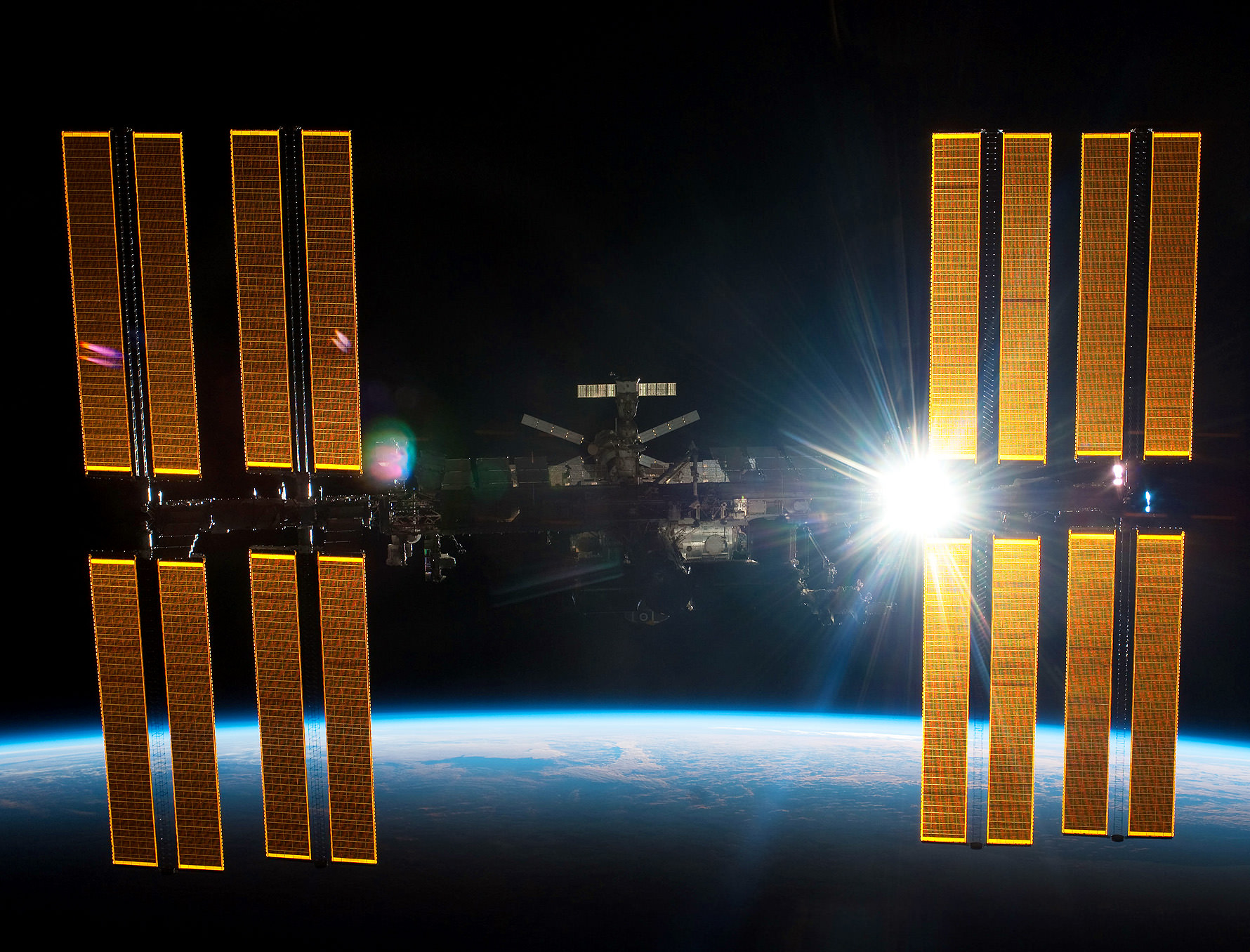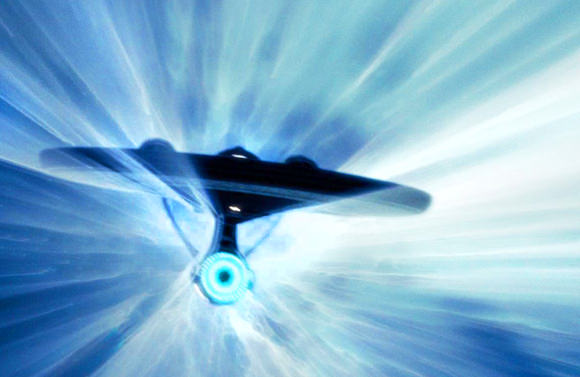When you consider the hazards of spaceflight, it’s hard to get worked up about dust bunnies. And yet, atmospheric dust is going to be one of the biggest problems astronauts will face when they reach the surface of other worlds. Where does this dust come from, and what does it tell us about the history of other worlds, and what can we do to mitigate the health risks?
Continue reading “Astronomy Cast Ep. 326: Atmospheric Dust”
Why Is Balancing So Hard After Spaceflights? Astronaut Posture Could Hold Clues

OTTAWA, CANADA – Astronauts appear to hold their heads more rigidly in relation to their trunks after returning to Earth from multi-month spaceflights, which may affect how they balance themselves back on Earth, according to ongoing research.
A note of caution: the sample size is small (six astronauts so far) and the research is still being conducted by the University of Houston and NASA. So this isn’t finalized in any sense. The early studies, however, shows that people returning to Earth may be changing their “strategy”, said Ph.D. student Stefan Madansingh.
“The changing strategy might put you at higher risks of falls as you ambulate around your environment, and if you are on Mars and you fall and break your hip, that is the start of a very bad day,” he said in a speech.
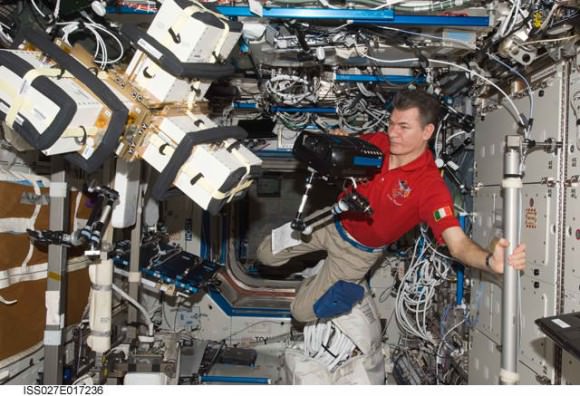
Generally, NASA is interested in learning about changes in cardiovascular, balance and muscle function after six-month spaceflights or more, when they are “like spaghetti people,” Madansingh said. Over the years, astronauts have shown changes in inner eye pressure, bone density, muscles and their balance, among other things.
To obtain the information, NASA has had astronauts walking around a simple obstacle course, which they encourage astronauts to complete at a comfortable walking pace. They’ll weave around pylons, climb ladders and do other simple tasks.
Tests are performed at 180, 60 and 30 days before launch, then one, six and 30 days after landing. (In the shuttle era, astronauts would do these types of tests immediately after landing, but these days there’s a day-long flight from Kazakhstan before arriving in Houston.) Some tests are started from a lying position, and some from a sitting position.
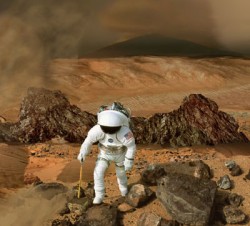
It takes more time for astronauts to complete the obstacle course after coming back from space, Madansingh said, and his ongoing research looks at the relation between the head and trunk as the astronauts are doing so.
As controls, NASA uses bed rest subjects, who are people voluntarily spending 70 days in a head-down position without getting up once, even to go to the bathroom. “I think it’s absolutely bonkers,” Madansingh joked, but added that the bed rest subjects don’t show that same head-trunk changes that returning astronauts do. More research will be needed to learn why, he said.
NASA is putting particular emphasis on these studies as astronauts spend longer times in space. The first one-year International Space Station stay is scheduled for 2015, although some cosmonauts have spent a year or more on the Russian space station Mir.
Madansingh delivered his comments Nov. 15 at the Canadian Space Society annual conference in Ottawa.
Navigating the Cosmos by Quasar
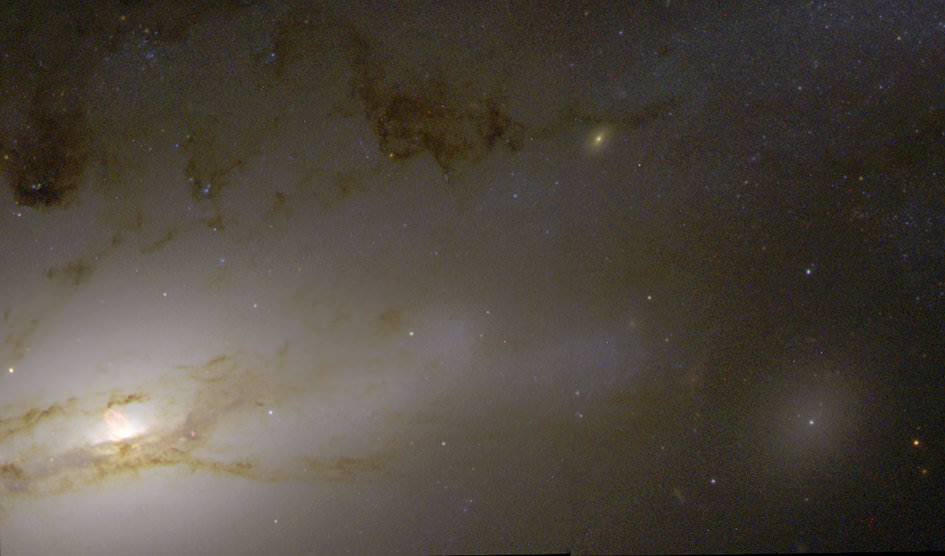
50 million light-years away a quasar resides in the hub of galaxy NGC 4438, an incredibly bright source of light and radiation that’s the result of a supermassive black hole actively feeding on nearby gas and dust (and pretty much anything else that ventures too closely.) Shining with the energy of 1,000 Milky Ways, this quasar — and others like it — are the brightest objects in the visible Universe… so bright, in fact, that they are used as beacons for interplanetary navigation by various exploration spacecraft.
“I must go down to the seas again, to the lonely sea and the sky,And all I ask is a tall ship and a star to steer her by.”– John Masefield, “Sea Fever”
Deep-space missions require precise navigation, especially when approaching bodies such as Mars, Venus, or comets. It’s often necessary to pinpoint a spacecraft traveling 100 million km from Earth to within just 1 km. To achieve this level of accuracy, experts use quasars – the most luminous objects known in the Universe – as beacons in a technique known as Delta-Differential One-Way Ranging, or delta-DOR.
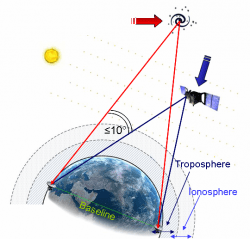
Delta-DOR uses two antennas in distant locations on Earth (such as Goldstone in California and Canberra in Australia) to simultaneously track a transmitting spacecraft in order to measure the time difference (delay) between signals arriving at the two stations.
Unfortunately the delay can be affected by several sources of error, such as the radio waves traveling through the troposphere, ionosphere, and solar plasma, as well as clock instabilities at the ground stations.
Delta-DOR corrects these errors by tracking a quasar that is located near the spacecraft for calibration — usually within ten degrees. The chosen quasar’s direction is already known extremely well through astronomical measurements, typically to closer than 50 billionths of a degree (one nanoradian, or 0.208533 milliarcsecond). The delay time of the quasar is subtracted from that of the spacecraft’s, providing the delta-DOR measurement and allowing for amazingly high-precision navigation across long distances.
“Quasar locations define a reference system. They enable engineers to improve the precision of the measurements taken by ground stations and improve the accuracy of the direction to the spacecraft to an order of a millionth of a degree.”
– Frank Budnik, ESA flight dynamics expert
So even though the quasar in NGC 4438 is located 50 million light-years from Earth, it can help engineers position a spacecraft located 100 million kilometers away to an accuracy of several hundred meters. Now that’s a star to steer her by!
Read more about Delta-DOR here and here.
Source: ESA Operations
An Unexpected Ending for Deep Impact
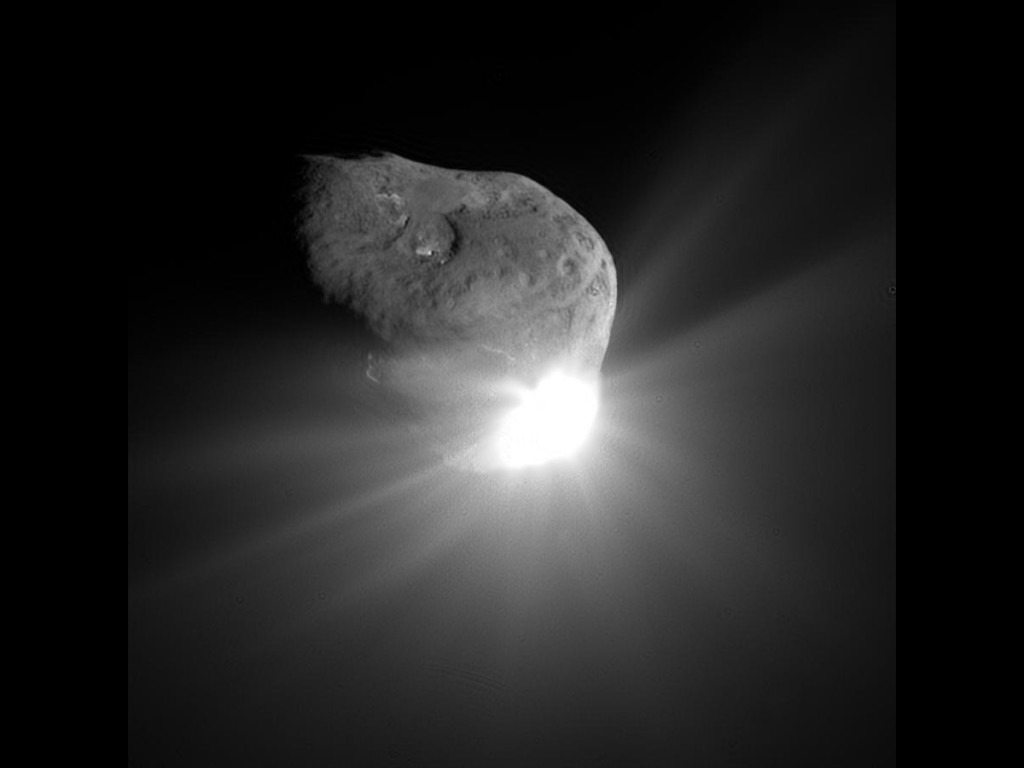
After almost 9 years in space that included an unprecedented July 4th impact and subsequent flyby of a comet, an additional comet flyby, and the return of approximately 500,000 images of celestial objects, NASA’s Deep Impact/EPOXI mission has officially been brought to a close.
The project team at NASA’s Jet Propulsion Laboratory has reluctantly pronounced the mission at an end after being unable to communicate with the spacecraft for over a month. The last communication with the probe was Aug. 8. Deep Impact was history’s most traveled comet research mission, having journeyed a total of about 4.7 billion miles (7.58 billion kilometers).
“Deep Impact has been a fantastic, long-lasting spacecraft that has produced far more data than we had planned,” said Mike A’Hearn, the Deep Impact principal investigator at the University of Maryland in College Park. “It has revolutionized our understanding of comets and their activity.”
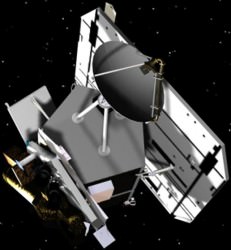
Launched in January 2005, the spacecraft first traveled about 268 million miles (431 million kilometers) to the vicinity of comet Tempel 1. On July 3, 2005, the spacecraft deployed an impactor into the path of comet to essentially be run over by its nucleus on July 4. This caused material from below the comet’s surface to be blasted out into space where it could be examined by the telescopes and instrumentation of the flyby spacecraft. Sixteen days after that comet encounter, the Deep Impact team placed the spacecraft on a trajectory to fly back past Earth in late December 2007 to put it on course to encounter another comet, Hartley 2 in November 2010, thus beginning the spacecraft’s new EPOXI mission.
“Six months after launch, this spacecraft had already completed its planned mission to study comet Tempel 1,” said Tim Larson, project manager of Deep Impact at JPL. “But the science team kept finding interesting things to do, and through the ingenuity of our mission team and navigators and support of NASA’s Discovery Program, this spacecraft kept it up for more than eight years, producing amazing results all along the way.”
The spacecraft’s extended mission culminated in the successful flyby of comet Hartley 2 on Nov. 4, 2010. Along the way, it also observed six different stars to confirm the motion of planets orbiting them, and took images and data of the Earth, the Moon and Mars. These data helped to confirm the existence of water on the Moon, and attempted to confirm the methane signature in the atmosphere of Mars. One sequence of images is a breathtaking view of the Moon transiting across the face of Earth.
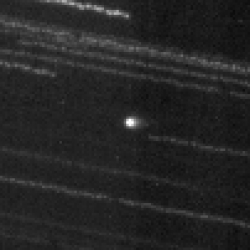
The spacecraft’s extended mission culminated in the successful flyby of comet Hartley 2 on Nov. 4, 2010. In January 2012, Deep Impact performed imaging and accessed the composition of distant comet C/2009 P1 (Garradd).
It took images of comet ISON this year and collected early images of comet ISON in June.
After losing contact with the spacecraft last month, mission controllers spent several weeks trying to uplink commands to reactivate its onboard systems. Although the exact cause of the loss is not known, analysis has uncovered a potential problem with computer time tagging that could have led to loss of control for Deep Impact’s orientation. That would then affect the positioning of its radio antennas, making communication difficult, as well as its solar arrays, which would in turn prevent the spacecraft from getting power and allow cold temperatures to ruin onboard equipment, essentially freezing its battery and propulsion systems.
Without battery power, the Deep Impact spacecraft is now adrift and silent, spinning out of control through the solar system.
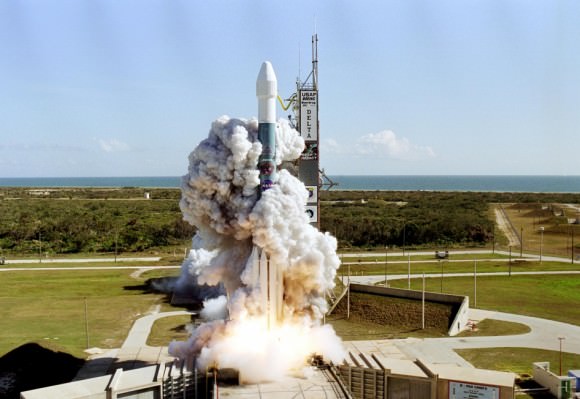
“Despite this unexpected final curtain call, Deep Impact already achieved much more than ever was envisioned. Deep Impact has completely overturned what we thought we knew about comets and also provided a treasure trove of additional planetary science that will be the source data of research for years to come.”
– Lindley Johnson, Program Executive for the Deep Impact mission
It’s a sad end for a hardworking spacecraft, but over the course of its 8 1/2 years in space Deep Impact provided many significant results for the science community. Here are the top five, according to the mission’s principal investigator Michael A’Hearn.
Read more about the Deep Impact mission here.
Source: NASA press release
How to Spot the Antares Launch from NASA Wallops on Wednesday

A space launch marking a new era is departing from the Virginia coast this Wednesday evening, and if you live anywhere along a wide area of the US Eastern seaboard, you’ll have a great opportunity to witness the launch with your own eyes. Here’s all the information you’ll need to see it, plus some tips for capturing it with your camera.
Orbital Sciences’ Antares rocket will launch from Pad 0A at NASA’s Mid-Atlantic Regional Spaceport based on Wallops Island, Virginia. This will mark not only the first launch of Antares, but the first orbital launch of a liquid-fueled rocket from Wallops. The launch window runs from 5:00 to 8:00 PM EDT (21:00-24:00 UT).
There were some concerns when a technical anomaly shutdown a “Wet Dress Rehearsal” test this weekend at T-16 minutes, but Orbital Sciences has stated that the problems have been resolved and the launch is pressing ahead as planned.
Space shots are a familiar sight to the residents of the Florida Space Coast, but will provide a unique show for residents of the U.S. central Atlantic region. The launch of Antares from Wallops will be visible for hundreds of miles and be over 10° above the horizon for an arc spanning from Wilmington, North Carolina to Washington D.C. and north to the New York City tri-state area as it heads off to the southeast. Antares is a two stage rocket with a 1st stage liquid fueled engine and a solid-fueled 2nd stage. The primary mission for Wednesday’s Antares A-One flight will be to demonstrate the ability for the Antares rocket to place a payload into orbit. If all goes well, Orbital Sciences will join SpaceX this summer in the select club of private companies with the ability provide cargo delivery access to the International Space Station in Low Earth Orbit.
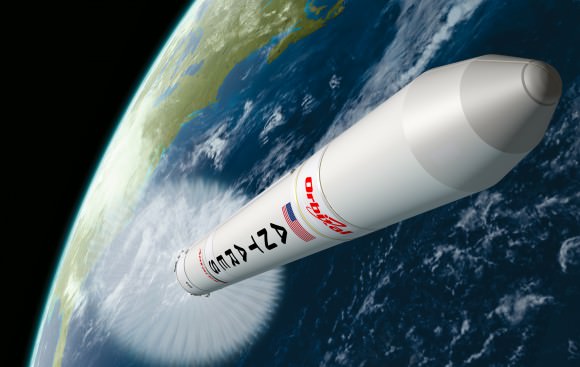
Antares will deploy a dummy mass simulating the Cygnus module. Also onboard are the Phonesat-1a, -1b, and -1c micro-cubesats and the Dove 1 satellite.
Be sure to watch for the launch of Antares if you live in the region. Find a spot with a low uncluttered eastern horizon and watch from an elevated rooftop or hilltop location if possible. I live a hundred miles west of Cape Canaveral and I’ve followed launches all the way through Main Engine Cutoff and first stage separation with binoculars.
Be sure to also follow the launch broadcast live for any last minute delays via NASA TV or Universe Today will have a live feed as well. Antares is aiming to put the Cygnus test mass in a 250 x 300 kilometre orbit with a 51.6° inclination. This is similar to what will be necessary to head to the ISS, but this week’s launch will not be trailing the ISS in its path. This also means that the launch window can be extended over three hours rather than having to be instantaneous.
If the launch goes at the beginning of the window, the local sun angle over the launch facility will be 30° to the west. Sunset at Wallops on the evening of April 17th occurs at 7:41PM EDT, meaning we could be in for a photogenic dusk launch of Antares if it stretches to the end of the target window.
And speaking of which, a pre-sunset launch means short daytime exposure settings for photography. Be prepared to switch over for dusk conditions if the launch extends into the end of the window. Conditions during twilight can change almost moment-to-moment. One of the most memorable launches we witnessed was the pre-dawn liftoff of STS-131 on April 5th, 2010:
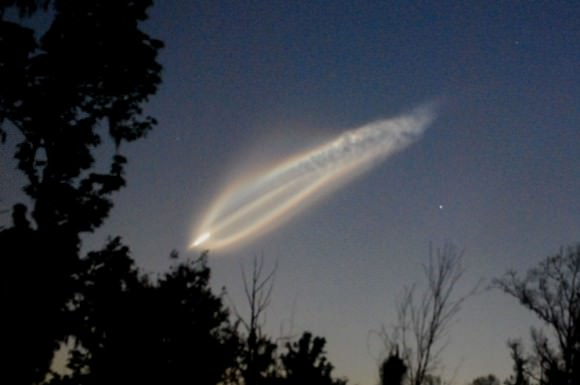
Once in orbit, the launch of Antares should generate four visible objects; the test mass payload, the two clam-shell fairings, and the stage two booster. This configuration is similar to a Falcon 9/Dragon launch, minus the solar panel covers. These objects should be visible to the naked eye at magnitudes +3 to +5. The cubesat payloads are tiny and below the threshold of naked eye visibility.
Preliminary visibility for the objects will favor latitudes 0-30° north at dusk to 10-40° at dawn. Keep in mind these predictions could change as the launch window evolves. The next NORAD tracking ID in the queue is 2013-015A. Yesterday’s launch of Anik G1 from Baikonur was just cataloged today as 2013-014A plus associated hardware. The weather is forecast to be 45% “go” for tomorrow’s launch. In the event of a scrub, the next launch window for Antares is April 18-21st.
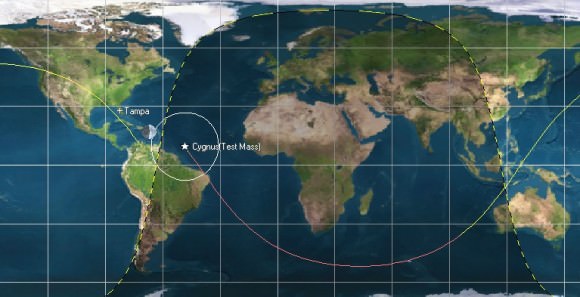
It’ll be exciting to follow this first flight of Antares and its first scheduled mission to the International Space Station this summer. Also watch for the first ever lunar mission to depart Wallops on August 12 with the launch of the Lunar Atmosphere and Dust Environment Explorer (LADEE).
Finally, if you’ve got a pass of the International Space Station this week, keep an eye out for Progress M-17M currently about 10 minutes ahead of the station in its orbit. The unmanned Progress vehicle just undocked yesterday from the station and will be conducting a series of experiments monitoring the interactions of its thrusters with the ionosphere before burning up on reentry over the South Pacific on April 21st.
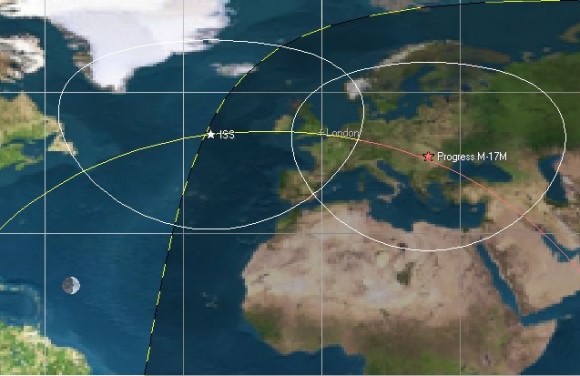
The ISS and more can be tracked using Heavens-Above. Also, we’ll be tweeting all of the updates and orbital action as it evolves as @Astroguyz. Let us know of those launch sightings both near and far. It’ll be interesting to see what, if any, impact launches visible to a large portion of the U.S. population will have on the public’s perception of spaceflight. Be sure to look up tomorrow night!
Morpheus Lander Crashes and Burns
NASA’s “lean and green” Morpheus lander crashed and burned during a free flight test at Kennedy Space Center today, August 9, at approximately 12:46 pm EDT.
Watch a video of the failed test after the jump:
Designed in-house at Johnson Space Center, the Morpheus lander is engineered to use a liquid oxygen and methane fuel — relatively cheap materials that can be stored easily and would be available resources on other worlds besides Earth.
Morpheus’ first successful tethered flight had just occurred a few days earlier, on August 3.
It IS still rocket science, after all…
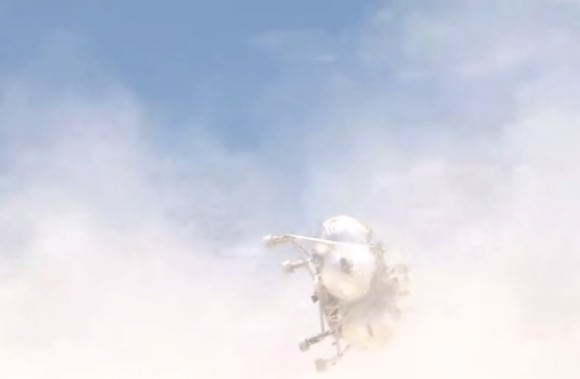
Images: NASA TV
Expedition 31 Blasts Off!
[/caption]
After a six-week delay, the crew of Expedition 31 successfully launched aboard a Soyuz TMA-04M rocket on Tuesday, May 15 at 0301 GMT (11:01 p.m. EDT May 14) from Russia’s historic Baikonur Cosmodrome, located in the steppes of Kazakhstan.
The rocket will deliver NASA astronaut Joe Acaba and Russian cosmonauts Gennady Padalka and Sergei Revin to the International Space Station. After a two-day journey, their Soyuz capsule will dock with the ISS at 11:38 p.m. CDT on Wednesday.
The launch was aired live by NASA HD TV. The full launch can be viewed below:
The crew was originally slated to launch on March 30, but problems with a pressure test forced a delay until a new Soyuz rocket could be brought into service. In the meantime ISS crew members Don Pettit, ESA astronaut Andre Kuipers and cosmonaut Oleg Kononenko have had the station to themselves since April 27.
The three new crew members will remain on Space Station until mid-September, serving as flight engineers under Expedition 31 commander Oleg Kononenko until July 1, when the current crew will depart and Padalka will assume command, marking the beginning of Expedition 32.
For more news on Expedition 31, visit NASA’s ISS website here. Also, you can follow NASA astronaut Joe Acaba on Twitter @AstroAcaba.
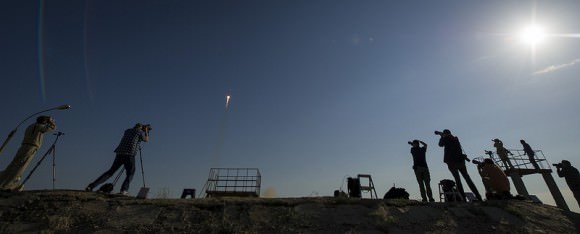
Video credit: NASA TV. Images: NASA/Bill Ingalls
The View From Freedom 7
51 years ago today, on May 5, 1961, NASA launched the Mercury-Redstone 3 rocket carrying Alan B. Shepard, Jr. aboard the Freedom 7 capsule. Shepard successfully became America’s first man in space, making a brief but historic suborbital test flight that propelled American astronauts into the space race of the 1960s.
The video above is made from photographs taken by a film camera mounted to the Freedom 7 spacecraft and scanned by archivists at Johnson Space Center. It shows the view from Freedom 7 as the Redstone rocket launched it into space, getting an amazing view of Earth’s limb and the blackness beyond before falling back to splash down in the Atlantic.
The video is made from the entire film reel, so at the end there’s also some shots of a light experiment inside the spacecraft. (View the individual scans at ASU’s March to the Moon website here.)
What’s amazing to realize is that, at this point in time, the space surrounding our planet was a very empty place. This was a time before communication and weather satellites, before GPS, before Space Station and space shuttles — and space junk — and student-made weather balloon videos. Just 51 years ago low-Earth orbit was a new frontier, and guys like Shepard (and Gagarin and Glenn, etc.) were blazing the path for everyone that followed.
Even though images of Earth from space are still amazing to look at today, seeing these photos reminds us of a time when it was all just so very new.
Read more about Shepard and the MR-3 launch here.
Images and video: NASA/JSC/Arizona State University
[/caption]
NanoRacks and CASIS Put Research on the Universe’s Front Porch
[/caption]
The Center for the Advancement of Science in Space (CASIS) has opened part of the ISS exterior to research experiments via NanoRacks, a company providing plug-and-play platforms aboard the Station to third-party research organizations. For the first time, commercial experiments will have a dedicated external space aboard the ISS, putting them on “the front porch of the Universe.”
Since 2009 NanoRacks has been providing research institutions with shoebox-sized consoles that can house customized experiments for installation inside the U.S. National Laboratory on board the ISS.
On April 12 CASIS announced a $1.5 million deal with NanoRacks that will allow an external “NanoLabs” platform to be installed on the Japanese Kibo module. The structure will provide research spaces up to 8″ square that will be exposed to the environment of space. (Watch a video of the NanoLabs concept below.)
Through the CASIS investment, as many as four companies will be able to fly experiments for little or no cost.
A formal solicitation to research companies and private enterprises for payload proposals will be issued by CASIS in June. The NanoLabs platform is expected to be ready for flight by 2013 — a full year ahead of schedule.
“CASIS’ investment ensures that U.S. researchers will have access to the ISS External Platform far sooner than otherwise expected,” stated Jeffrey Manber, Managing Director of NanoRacks . “This program will enable faster innovation and spiral development for payloads — an opportunity that has not previously been made available to the commercial marketplace.”
Read the full press release here.
NanoRacks LLC was formed in 2009 to provide quality hardware and services for the U.S. National Laboratory onboard the International Space Station. The company operates the first commercial laboratory in low-earth orbit. The Center for the Advancement of Science in Space (CASIS) was selected by NASA in July 2011 to maximize use of the International Space Station U.S. National Laboratory through 2020.
Image: S134-E-011413 — A backlit ISS photographed by the STS-134 crew of Endeavour on May 29, 2011, after undocking from the Station. (NASA)
Warp Drives May Come With a Killer Downside
[/caption]
Planning a little space travel to see some friends on Kepler 22b? Thinking of trying out your newly-installed FTL3000 Alcubierre Warp Drive to get you there in no time? Better not make it a surprise visit — your arrival may end up disintegrating anyone there when you show up.
“Warp” technology and faster-than-light (FTL) space travel has been a staple of science fiction for decades. The distances in space are just so vast and planetary systems — even within a single galaxy — are spaced so far apart, such a concept is needed to make casual human exploration feasible (and fit within the comforts of people’s imagination as well… nobody wants to think about Kirk and Spock bravely going to some alien planet while everyone they’ve ever known dies of old age!)
While many factors involving FTL travel are purely theoretical — and may remain in the realm of imagination for a very long time, if not ever — there are some concepts that play well with currently-accepted physics.
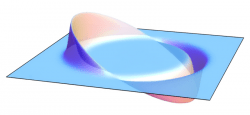
The Alcubierre warp drive is one of those concepts.
Proposed by Mexican theoretical physicist Miguel Alcubierre in 1994, the drive would propel a ship at superluminal speeds by creating a bubble of negative energy around it, expanding space (and time) behind the ship while compressing space in front of it. In much the same way that a surfer rides a wave, the bubble of space containing the ship and its passengers would be pushed at velocities not limited to the speed of light toward a destination.
Of course, when the ship reaches its destination it has to stop. And that’s when all hell breaks loose.
Researchers from the University of Sydney have done some advanced crunching of numbers regarding the effects of FTL space travel via Alcubierre drive, taking into consideration the many types of cosmic particles that would be encountered along the way. Space is not just an empty void between point A and point B… rather, it’s full of particles that have mass (as well as some that do not.) What the research team — led by Brendan McMonigal, Geraint Lewis, and Philip O’Byrne — has found is that these particles can get “swept up” into the warp bubble and focused into regions before and behind the ship, as well as within the warp bubble itself.
When the Alcubierre-driven ship decelerates from superluminal speed, the particles its bubble has gathered are released in energetic outbursts. In the case of forward-facing particles the outburst can be very energetic — enough to destroy anyone at the destination directly in front of the ship.
“Any people at the destination,” the team’s paper concludes, “would be gamma ray and high energy particle blasted into oblivion due to the extreme blueshifts for [forward] region particles.”
In other words, don’t expect much of a welcome party.
Another thing the team found is that the amount of energy released is dependent on the length of the superluminal journey, but there is potentially no limit on its intensity.
“Interestingly, the energy burst released upon arriving at the destination does not have an upper limit,” McMonigal told Universe Today in an email. “You can just keep on traveling for longer and longer distances to increase the energy that will be released as much as you like, one of the odd effects of General Relativity. Unfortunately, even for very short journeys the energy released is so large that you would completely obliterate anything in front of you.”
So how to avoid disintegrating your port of call? It may be as simple as just aiming your vessel a bit off to the side… or, it may not. The research only focused on the planar space in front of and behind the warp bubble; deadly postwarp particle beams could end up blown in all directions!
Luckily for Vulcans, Tatooinians and any acquaintances on Kepler 22b, the Alcubierre warp drive is still very much theoretical. While the mechanics work with Einstein’s General Theory of Relativity, the creation of negative energy densities is an as-of-yet unknown technology — and may be impossible.
Which could be a very good thing for us, should someone out there be planning a surprise visit our way!
Read more about Alcubierre warp drives here, and you can download the full University of Sydney team’s research paper here.
Thanks to Brendan McMonigal and Geraint Lewis for the extra information!
Main image © Paramount Pictures and CBS Studios. All rights reserved.

